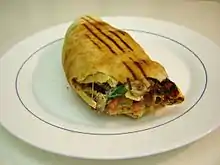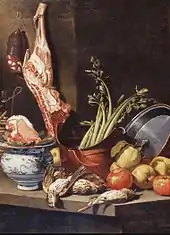Syrian cuisine
Syrian cuisine includes the cooking traditions and practices of modern Syria (as opposed to Greater Syria), merging the habits of people who settled in Syria throughout its history.
%252C_a_traditional_Ancient_Roman_recipe_for_a_classic_fine_bread%252C_from_Athenaeus'_Deipnosophistae_(16336232886).jpg.webp)

Syrian cuisine mainly uses eggplant, zucchini, garlic, meat (mostly from lamb and sheep), sesame seeds, rice, chickpeas, fava beans, lentils, cabbage, cauliflower, vine leaves, pickled turnips, cucumbers, tomatoes, olive oil, lemon juice, mint, pistachios, honey and fruits.
At the beginning of the 21st century, selections of appetizers known as "mezze" are customarily served along with Arabic bread before the Syrian meal's main course, which is followed by coffee, with sweet confectioneries or fruits at will. Many recipes date from at least the 13th century.[1]
Foods
Meze
Meze include:
| Name | Description |
|---|---|
| Hummus (حمص) | a dip or spread made from cooked, mashed chickpeas, blended with tahini, olive oil, lemon juice, salt and garlic. |
| Hummus bil-lahm (حمص باللحم) | hummus with meat on top. |
| Tabbouleh (تبولة) | bulgur, finely chopped parsley, mint, tomato, spring onion, with lemon juice, olive oil and seasonings. |
| Mutabbal (متبل) | mashed eggplant (aubergine) blended with tahini, olive oil, salt and garlic. |
| Babaghanoush (بابا غنوج) | eggplant (aubergine) mashed and mixed with seasonings. |
| Moussaka (مسقعة) | grilled eggplant (aubergine) mashed with olive oil, tomato, onion and garlic. |
| Fasolia bi zeit (فاصوليا بزيت) | green beans with olive oil, lemon and garlic. |
| Kibbeh (كبة) | in the Middle East– dishes made of bulghur, chopped meat, and spices. |
| Fattoush (فتوش) | salad made from several garden vegetables and toasted or fried pieces of pita bread. |
| Falafel (فلافل) | a deep-fried ball or patty made from ground chickpeas, fava beans, or both. |
| Olives (زيتون) | |
| Halloumi cheese (جبنة حلومي) | usually sliced and grilled or fried. |
| Labneh (لبنة) | strained yogurt which tastes similar to cream or sour cream only more tart. |
| Shanklish (شنكليش) | cow's milk or sheep's milk cheeses. |
| Makdus (مكدوس) | Stuffed and pickled eggplants. |
| Muhammarah (محمرة) | a hot pepper dip from Aleppo,[2] made from Aleppo pepper. |
| Fatteh (فتّة) | pieces of Arabic bread covered with other ingredients. |
| Fatteh bi-s-samn (فتّة بالسمن) | Fatteh made with beef or sheep tallow. |
| Fatteh bi-z-zayt (فتّة بالزيت) | Fatteh made with vegetable, corn, or olive oil. |
| Fatteh al-makdus (فتّة المكدوس) | Fatteh with makdus and minced meat. |
| Fatteh dajaj (فتّة دجاج) | Fatteh with chicken. |
| Fatteh bi-l-lahm (فتّة باللحم) | Fatteh with meat. |
| Lahmacun (لحم بعجين) | a thin piece of dough topped with minced meat and vegetables. |
| Harra' Esbao'o (حراق اصبعو) | lentils with dough |
| Baterish (باطرش) | mashed roasted eggplant |
| Shakeria (شاكرية) | cooked yoghurt |
| Makmur (مكمور) | chopped zucchini with rice |
| Jez Mez (جظ مظ) | a sort of Shakshouka |
| Kashk (كشك) | drained yogurt |
Vine leaves
| Name | Description |
|---|---|
| Yabrak (يبرق) | Vine leaves stuffed with rice and minced meat cooked and served hot. |
| Yalanji (يالانجي) | Vine leaves stuffed with rice and a variety of vegetables and served hot or cold. |
Kebab

| Name | Description |
|---|---|
| Kebab (كباب) | Grilled meat. |
| Kebab Halabi (كباب حلبي meaning "Aleppine kebab") | Kebab served with a spicy tomato sauce and Aleppo pepper. It has about 26 variants,[3] including:
|
Kubbeh
A variety of Syrian dishes made from a fried, baked, grilled, cooked, or raw mixture of bulghur and minced lamb are called "kubbeh" (كبّة). Kubbeh recipes include:
| Name | Description |
|---|---|
| Kubbeh bi-s-siniyyeh (كبّة بالصينيّة meaning "plate kubbeh") | A plate of baked kubbeh. |
| Kubbeh Halab (كبّة حلب) | Kubbeh with a rice crust. Although named after Aleppo, this recipe seems to be of Iraqi origin. |
| Kubbeh hamid (كبّة حامض) | Kubbeh with lemon juice. |
| Kubbeh labaniyyeh (كبّة لبنيّة) | Cooked kubbeh with yogurt. |
| Kubbeh 'qras Grilled ((كبّة أقراص (مشوية) | Grilled kubbeh. |
| Kubbeh nayyeh (كبّة نيّة) | Raw kubbeh. |
| Kubbeh safarjaliyyeh (كبّة سفرجليّة) | Kubbeh with quince. |
| Kubbeh summa'iyyeh (كبّة سمّاقيّة) | Kubbeh with sumac. |
Mahshi
A famous dish served in Syria is made from vegetables (usually zucchini—كوسا / kūsā—or eggplant—باذنجان / bādhinjān) which are stuffed (محشي / maḥshī) with ground beef or lamb or mutton, nuts, and rice.
Street food

Syrian street food includes:
| Name | Description |
|---|---|
| Booza (بوظة) | Ice cream known for its elastic texture, which is caused by the presence of mastic. |
| Falafil (فلافل) | Fried balls or patties of spiced, mashed chickpeas, most often served in Arabic bread, with pickles, tahina, hummus, sumac, cut vegetable salad and often, shatteh, a hot sauce, the type used depending on the falafil maker. |
| Ka'ak (كعك) | Rings of bread, made from farina and other ingredients, commonly sprinkled with sesame seeds, occasionally served on the table to accompany Syrian cheese. A buttery and sweetened version of these, filled with crushed dates or walnuts, is eaten as a dessert, usually served to eat with string cheese shaped into a braid (jibneh mashallaleh). |
| Shawarma (شاورما) | Sliced and marinated meat shaved off a roasting skewer and stuffed into Arabic bread or sometimes baguette, alone with hummus, or with additional trimmings such as fresh onion, French fries, salads and pickles. |
| Manakish (مناقيش) | Dough topped with thyme, cheese or ground meat. It can be sliced or folded, and it can be served either for breakfast or lunch. |
Sweets

Sweets include:
| Name | Description |
|---|---|
| Ba'lawah (بقلاوة) | Layered pastry filled with nuts, steeped in a honey syrup called "'atr" (قطر), and usually cut in a triangular or diamond shape. |
| Barazek (برازق) | A sort of sesame seed cookies, made from white sesame seeds, butter, sugar, milk and honey.[4] |
| Basbousa (بسبوسة) | A sweet cake made of cooked semolina or farina soaked in simple syrup. |
| Bashmina (البشمينا) | Made mainly from flour with a honey syrup called "'atr" (قطر).[5] |
| Bilatat Jahanam (بلاطة جهنم meaning "Hell's tile") | Made mainly from sugar and flour with a red food coloring.[6] |
| Crêpe (كريب) | A very thin French pastry with butter and sugar. |
| Ghazal al-banat (غزل البنات) | Sugar cotton candy stuffed with pistachios or cashew. |
| Halawet al-jibn (حلاوة الجبن) | Pastry rolled and stuffed with cheese or thick milk cream, served with a honey syrup called "'atr" (قطر). |
| Halaweh Homsiyyeh (حلاوة حمصيّة) | Also known as al Qurmashliya, made from flour, water and salt, then fried with oil until they form little pieces, which would be colored afterwards.[7] |
| Halweh (حلوة) | A slab of sesame paste studded with fruit and candy/sweets. |
| Haytaliya (هيطلية) | A sort of milk pudding. |
| Kanafeh (كنافة) | Shoelace pastry dessert stuffed with sweet white cheese, nuts and syrup. |
| Ma'mul (معمول) | Biscuits filled with dates, pistachios or walnuts, and shaped in a wooden mould called "tabi'" (طابع). It is a popular sweet on Christian holidays (Easter), Muslim holidays ('Id al-Fitr), and Jewish holidays (Purim). |
| Mamuniyyeh (مامونيّة) | Mixture of semolina and ghee butter simmered in water with sugar, usually served with salty cheese or milk cream called "qishteh" (قشطة). |
| Muhallebi (مهلبية) | A sort of milk pudding. |
| Nabulsiyyeh (نابلسيّة) | A layer of semi-salty Nabulsi cheese covered with a semolina dough and drizzled with a honey syrup called "'atr" (قطر). |
| Qada'ef (قطايف) | Semolina dough stuffed with a paste made from sweet walnuts or milk cream, with a honey syrup called "'atr" (قطر). |
| Qamar al-Din (قمر الدين) | Dried apricot paste. |
| Raha (راحة) | A confection based on a gel of starch and sugar. |
| Rice pudding (رز بحليب) | Made from rice mixed with water or milk and other ingredients such as cinnamon. |
| Simsimiyah (السمسمية) | A confection of sesame seeds and sugar or honey, with some Saponaria.[6] |
| Suwar as-sitt (سوار الست meaning "lady's wristlet") | A disc-shaped pastry steeped in a honey syrup called "'atr" (قطر) while the centre is covered with smashed pistachios. |
| Taj al-malik (تاج الملك meaning "king's crown") | Round dry pastry, the centre of which is filled with pistachios, cashews or other nuts. |
| Zilabiyyeh (زلابيّة) | Thin sheets of semolina dough, boiled, rolled and stuffed with pistachios or milk cream called "qishteh" (قشطة). |
| Znud as-sitt (زنود الست meaning "lady's arms") | Phyllo pastries with various fillings. |
Cakes
- Nygella Cake
Cheeses
- Tresse cheese (Jibne Khadra) is a form of string cheese, that originates in Syria, known by its Arabic name Jibneh Mshallaleh .
- White cheese, a white hard cheese with a pronounced salty taste
- Shanklish, cow's milk or sheep's milk cheeses
- Halloumi cheese, a semi-hard, unripened, brined cheese
Beverages
| Name | Description |
|---|---|
| 'Ara' (عرق) | A distilled alcoholic spirit, transparent in color, made from anise seeds. |
| Wine (نبيذ) | An alcoholic beverage made from fermented grapes. |
| Syrian beer (البيرة السوريّة) | A beverage prepared from yeast-fermented malt, flavored with hops. |
| Syrian coffee (قهوة) | A beverage made from lightly roasted coffee beans along with cardamom, and served in small cups (same as the Turkish coffee). |
| Qamar al-Din (قمر الدين) | A thick apricot juice, typically served for Iftar during Ramadan. |
| Al-mateh (المته) | A caffeine-infused drink produced from ground yerba mate leaves and served hot. |
| Salep (سحلب) | A traditional winter beverage which is a flour made from the tubers of the orchid genus Orchis. Salep flour is consumed in beverages and desserts. |
| 'Ayran (عيران) | A yogurt-based beverage mixed with salt and water. |
| Polo (بولو) | Mint lemonade. |
| Jallab (جلاب) | A fruit syrup which can be combined with liquid to form a hot or warm beverage. |
| Qahweh bayda' (قهوة بيضاء meaning "white coffee") | A caffeine-free drink made from water and orange blossom water, sweetened with sugar at will, usually served in lieu of coffee. |
References
- Eddé, Anne-Marie. (1999). La Principauté ayyoubide d'Alep (579/1183 – 658/1260).
- The Culinary Institute of America (2008). Garde Manger: The Art and Craft of the Cold Kitchen (Hardcover ed.). Wiley. p. 53. ISBN 978-0-470-05590-8.
- "كونا :: المطبخ الحلبي ينفرد بتنوع اطعمته وطيب نكته 11/01/2006". kuna.net.kw.
- "Barazek (Sesame Pistachio Cookies)". food52.com. 25 October 2015.
- "البشمينا حلويات اختصت بها مدينة حمص". SANA (in Arabic). 11 February 2015.
- "بلاطة جهنم والبشمينا والقرمشلية والسمسمية حلويات حمصية لذتها في بساطتها". aawsat.com (in Arabic). 24 April 2010.
- "الحلوى القرمشلية.. ألوانها الزاهية تجذب المارة في حمص". SANA (in Arabic). 26 February 2015.
- Syrian wine Château Bargylus
Further reading
External links
![]() Media related to Cuisine of Syria at Wikimedia Commons
Media related to Cuisine of Syria at Wikimedia Commons








.jpg.webp)



